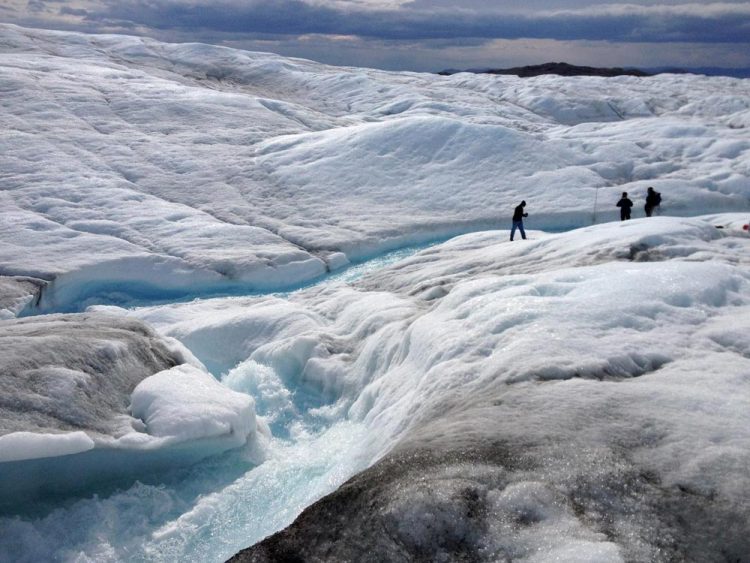Researchers discover fate of melting glacial ice in Greenland

A team from Rutgers University and the University of Georgia, led by Asa Rennermalm of Rutgers, measures meltwater runoff from the ice sheet margin in Greenland during summer 2013. Credit: Asa Rennermalm/Rutgers University
Now, a team of researchers led by faculty at the University of Georgia has discovered the fate of much of the freshwater that pours into the surrounding oceans as the Greenland ice sheet melts every summer. They published their findings today in the journal Nature Geoscience.
“Understanding the fate of meltwater is important, because research has shown that it can carry a variety of nutrients, which may impact biological production in the ocean,” said study co-author Renato Castelao, an associate professor of marine sciences in UGA's Franklin College of Arts and Sciences. “There is also evidence that large freshwater inputs could alter ocean currents and affect the normal formation of sea ice.”
The researchers created a simulation that tracks meltwater runoff under a variety of atmospheric conditions, and they were surprised to discover that most of the meltwater found off the west coast of Greenland actually originated from ice on the east coast.
“Meltwater from Greenland is directed by the surrounding ocean currents, but its fate depends on when and where the runoff occurs and the wind fields driving ocean currents,” said study co-author Thomas Mote, Distinguished Research Professor of Geography at UGA.
According to the model, wind and ocean currents often transport meltwater around the southern tip of Greenland on a westward journey that can take upward of 60 days. After rounding the tip, the meltwater is largely deposited into the Labrador Sea, an arm of the Atlantic between Canada's Labrador Peninsula and the east coast of Greenland.
Meltwater originating from the west coast of Greenland, on the other hand, is often kept pinned to the coastline by strong winds, which push it northward toward Baffin Bay.
This isn't always how meltwater from the Greenland ice sheet disperses, as shifts in the prevailing winds can produce very different effects. But scientists must be aware of these shifts in order to fully understand how meltwater will affect the environment, Castelao said.
“The meltwater that comes from the east coast could have different qualities from the meltwater on the west coast, including different nutrient compositions,” he said. “We need to take the origins of this meltwater into account when we study the effects of ice sheet melt, as it could impact the oceans differently depending on where it comes from.”
And this is a problem that is only going to get worse, said Castelao, citing scientific models that suggest the amount of meltwater runoff from Greenland could more than double before the end of this century.
“We need to pay careful attention to where melt and runoff is occurring and how it interacts with surrounding ocean currents, in addition to measuring the total amount of melt,” said Mote.
###
Other researchers working on this project include Hao Luo and Patricia Yager from UGA's department of marine sciences; Asa Rennermalm, Rutgers University; Marco Tedesco, Columbia University; and Annalisa Bracco, Georgia Institute of Technology.
Their study, “Oceanic transport of surface meltwater from the southern Greenland ice sheet,” is available at http://www.
Media Contact
All latest news from the category: Earth Sciences
Earth Sciences (also referred to as Geosciences), which deals with basic issues surrounding our planet, plays a vital role in the area of energy and raw materials supply.
Earth Sciences comprises subjects such as geology, geography, geological informatics, paleontology, mineralogy, petrography, crystallography, geophysics, geodesy, glaciology, cartography, photogrammetry, meteorology and seismology, early-warning systems, earthquake research and polar research.
Newest articles

NASA: Mystery of life’s handedness deepens
The mystery of why life uses molecules with specific orientations has deepened with a NASA-funded discovery that RNA — a key molecule thought to have potentially held the instructions for…

What are the effects of historic lithium mining on water quality?
Study reveals low levels of common contaminants but high levels of other elements in waters associated with an abandoned lithium mine. Lithium ore and mining waste from a historic lithium…

Quantum-inspired design boosts efficiency of heat-to-electricity conversion
Rice engineers take unconventional route to improving thermophotovoltaic systems. Researchers at Rice University have found a new way to improve a key element of thermophotovoltaic (TPV) systems, which convert heat…



